Have Blue States Always Been More Prosperous Than Red States
The Economy Really Is Worse in Blue States. But Why?
Four theories.
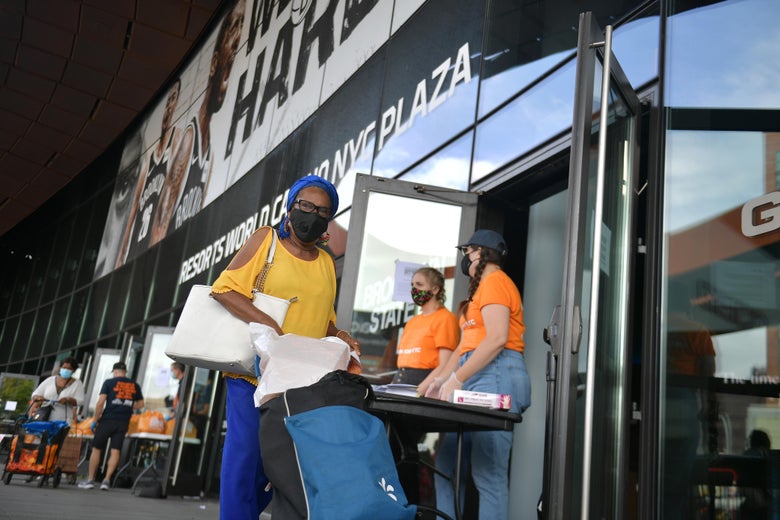
Seven months into the coronavirus crisis, the states with the most severe unemployment in the country all seem to have one thing in common: They vote blue.
In September, just eight states had jobless rates that were significantly higher than the nation as a whole, according to the Bureau of Labor Statistics. Each of them—New Mexico, Massachusetts, New York, Illinois, Rhode Island, California, Nevada, and Hawaii—backed Hillary Clinton in 2016, and all but Massachusetts had a Democratic governor.* These states did not suffer from unusually high unemployment rates before the pandemic began, but now are facing rates ranging from 9.4 percent up to 15.1 percent, compared with 7.9 percent nationally.
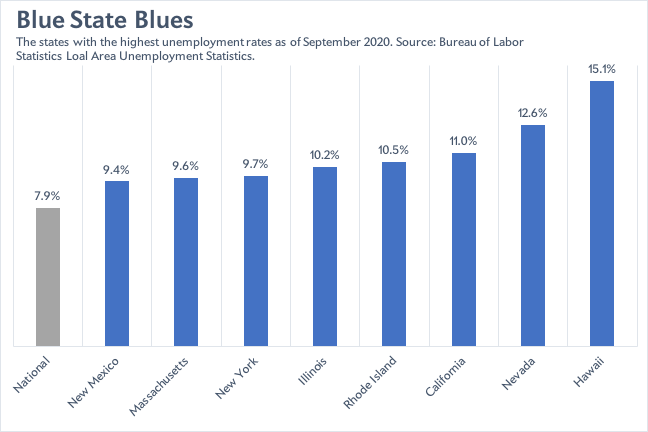
By contrast, the states with the lowest unemployment last month tilted red: Of the bottom 10—Nebraska, South Dakota, Vermont, North Dakota, Iowa, Missouri, Utah, South Carolina, Montana, and Oklahoma—eight both had a Republican governor and backed Donald Trump in the last election. All had jobless rates below 5.4 percent.
Even if you turn your attention away from the extremes, it's clear that the economic damage has been significantly worse overall in Biden Country, where employment has fallen 8.6 percent, than in Trump country, where it's down 4.6 percent, according to an analysis by Indeed.com economist Jed Kolko.
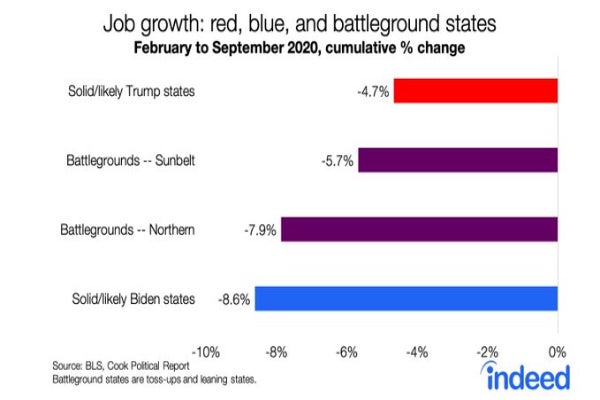
One consequence of this split is that states dominated by Democrats are facing somewhat deeper budget problems than ones led by Republicans, because the crisis has done more damage to their tax bases. Early in the crisis, it wasn't at all obvious this would be the case. But recent projections from economists at Brookings, the Federal Reserve, and the University of California–Berkeley suggest that, while almost all states are facing large revenue shortfalls next year, the largest will be in New York, Washington, California, and Hawaii. State and local aid wouldn't be a "blue state bailout," as Senate conservatives have claimed (Texas, Georgia, and Louisiana are facing plenty of fiscal challenges of their own). But deep blue states are in especially dire need of help.

Why, exactly, has the economic devastation been worst in liberal corners of the country? Unfortunately, there isn't a clear, consensus opinion among experts, and not many economists have tried to carefully probe the issue yet. "We don't know, in an econometric sense," Alan Berube, deputy director of the Brookings Metropolitan Policy Program, told me. Still, there are several possible causes—ranging from the kinds of lockdowns governors have imposed to the sorts of industries that different states rely on—each of which has at least some degree of plausibility.
Theory 1: It's the Shutdowns
One obvious possibility is that blue states are struggling with higher unemployment because they've been more aggressive about fighting the pandemic. After all, Democratic governors have often imposed stricter social distancing rules than their Republican counterparts, and it's reasonable to suspect that they've paid an economic price for prioritizing public health over allowing restaurants to fill their dining rooms back up. Studies suggest that the formal shutdowns and stay-at-home orders that states implemented this spring had much less to do with the country's initial economic collapse than did the public's fear of the pandemic, which caused Americans everywhere to start staying in regardless of the local rules in place. But it's possible that, as states have reopened at different paces, it's made a difference in their unemployment rates.
Certainly, that's what our president thinks. As he described blue states during last Thursday's debate, "They're shut down so tight and they're dying."
Trump is, as usual, overstating things (I know, try not to faint). But there may be at least a smidgen of evidence backing him up. Earlier this month, researchers at the personal finance site Wallet Hub ranked which states had the most COVID-related restrictions in place, using 17 different measures. They found that the states with the most rules—among them New York, California, Hawaii, New Jersey, and Massachusetts—tended to have the highest unemployment rates as well. Here's a version of their chart I whipped up, using change in joblessness, which is probably a more accurate measure.
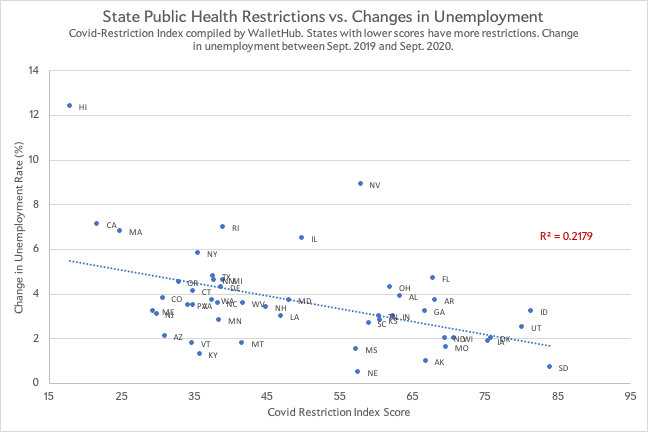
With that said, it's very clear that public health rules aren't the only factor at play. We also shouldn't discount the possibility that California and New York are suffering economically because their residents are just more cautious about going out than, say, Alabamians, in which case the problem isn't so much the shutdowns as the shut-ins.
Verdict: Public health restrictions might be weighing on the economy in some states, but that's not nearly the whole story. (Also, let's be clear: It's good that some states are choosing to save lives rather than maximize employment right now.)
Theory 2: It's About the Industries That Dominate Different States
Blue states may also be in deeper economic trouble because they are more reliant on service industries that have been broadly hurt by the pandemic. This is a point that economists like Indeed's Kolko and writers such as Bloomberg's Conor Sen have made but is probably still a bit underappreciated.
Take tourism. Nevada and Hawaii pretty much live and die by the grace of vacation travelers, who have disappeared, and as a result, they have the highest unemployment rates in the country. New York and California have much more balanced economies but are ordinarily home to two of the most visited destinations in country, New York City and Los Angeles. And while local coronavirus precautions may have kept some visitors away—nobody's heading to 42nd Street to catch a Broadway show, because the theaters are all closed—the tourist bust is also having an obvious effect in Republican-run states with looser rules. Orlando, Florida, for instance, is dealing with some of the worst job losses of any major metro area, even though Disney is open and Mickey is ready to greet your kids with a magical bottle of Clorox spray.
Or consider Hollywood. The motion picture and sound production industries have seen employment fell by 40 percent, as film shoots have ground largely to a halt in the pandemic. That blow has almost certainly rippled throughout the Los Angeles metro area's economy.
Meanwhile, any state with a large leisure and hospitality industry, whether it caters to locals or visitors, is feeling pain, since the whole restaurant industry has been decimated. Brookings' Berube found that there was a strong relationship between the share of a state's employment that was in "hard-hit" industries that saw double-digit percent declines in jobs after the pandemic, and how much unemployment rose.1
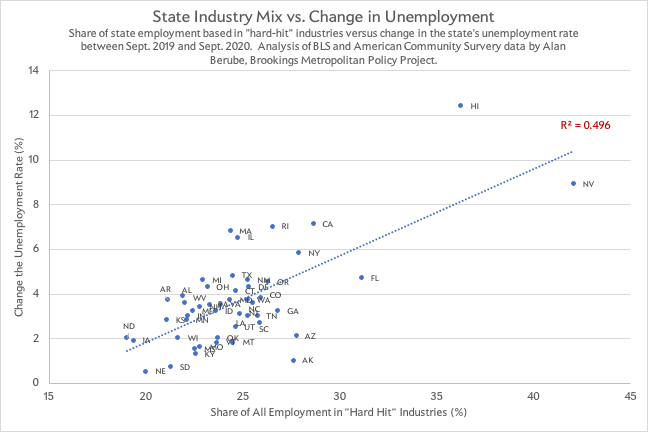
Verdict: Yes, when your major industries are decimated by a plague, it tends to hurt the local economy.
Theory 3: It's All the People Working From Home
You might assume having lots of professionals capable of working from home would be good for a state's economy right now. But in some ways, it might be counterproductive, since white-collar employees who log into a virtual office on Zoom aren't spending money buying lunch or getting their clothes dry-cleaned near their actual, brick-and-mortar offices. As Harvard's Opportunity Insights project has documented, small businesses have seen major revenue declines in central business districts like Lower Manhattan, Chicago's Loop, and San Francisco's Financial District. When Kolko looked at the share of workers in major metropolitan areas who could work from home, he found that it correlated with slightly higher local job losses, though the relationship was a bit weak. To some extent, blue states may be suffering because so much of their economic lifeblood comes from big cities with big downtowns.
Verdict: It probably isn't a huge cause for their woes, but the number of white-collar professionals who are permanently WFH isn't necessarily helping blue states economically either.
Theory 4: Could It Be the Unemployment Benefits?
Some conservatives might be tempted to assume that blue states' more plentiful unemployment benefits are keeping people from returning to work. There was widespread concern on the right that the $600-a-week federal payments Congress created early in the crisis would prevent Americans from returning to their jobs. And while there is no real evidence that was the case, likely because there were still more people willing to work for various reasons than there were jobs available, it's worth at least checking the possibility that as the crisis has worn on, states with a bigger, more supportive safety net are seeing a slower return to normal due to their generosity.
But that doesn't seem likely. There seems to be little to no relationship between changes in state unemployment rates and the generosity of their unemployment programs, measured by their "replacement rate," or the amount of their old pay workers receive on average.
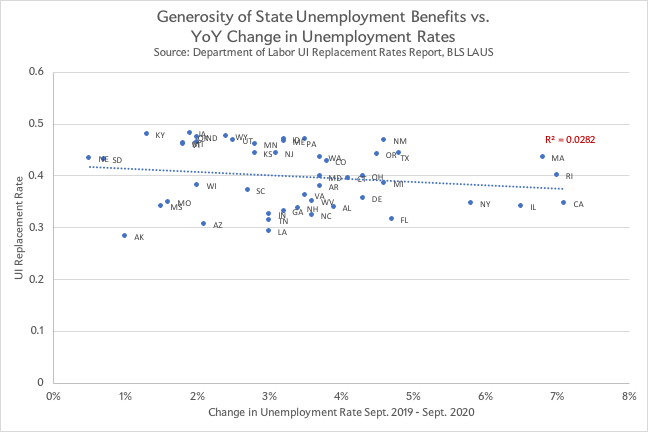
Verdict: No, the safety net is not turning into a hammock.
The Big Picture
Again, Republicans have been loath to pass fiscal aid for state and local governments, in part because they believed they would be bailing out irresponsible blue states. They probably aren't wrong about who needs the money most at this point. But the reason Democratic-run states are suffering more right now seems to come to down factors that are out of their hands, like the size of their service sectors, or to decisions that are saving lives.
1 If you remove Hawaii and Nevada, which are obviously outliers, r-squared on this chart falls to about 0.21. Not as strong, but about on par with public health restrictions.
Correction, Oct. 27, 2020: This article originally misstated that Massachusetts has a Democratic governor.
Source: https://slate.com/business/2020/10/economy-states-blue-red-trump-biden.html
0 Response to "Have Blue States Always Been More Prosperous Than Red States"
Post a Comment